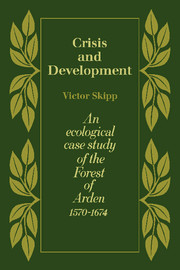Book contents
- Frontmatter
- Contents
- List of figures
- List of tables
- Acknowledgements
- PART ONE THE CONTEXT
- PART TWO THE CASE STUDY
- PART THREE IMPLICATIONS
- 12 General propositions
- 13 The ‘General European Crisis’
- 14 The Civil War alignment
- Appendix 1 The practice of birth control
- Appendix II Estimates of population size
- Notes
- Index
14 - The Civil War alignment
Published online by Cambridge University Press: 05 November 2011
- Frontmatter
- Contents
- List of figures
- List of tables
- Acknowledgements
- PART ONE THE CONTEXT
- PART TWO THE CASE STUDY
- PART THREE IMPLICATIONS
- 12 General propositions
- 13 The ‘General European Crisis’
- 14 The Civil War alignment
- Appendix 1 The practice of birth control
- Appendix II Estimates of population size
- Notes
- Index
Summary
An ecological account of the developments which culminated in the English Civil War would naturally concentrate on what Lawrence Stone has called ‘the pre-conditions, the long-term social, economic and ideological trends that make revolutions possible’; rather than ‘the triggers, the personal decisions and the accidental pattern of events which may or may not set off the revolutionary outbreak, and which are unique and unclassifiable’. Professor Stone himself discusses the long-term trends that have most interested us under an apposite title: ‘The development of disequilibrium, 1529–1629’. First and foremost, he calls attention to ‘The doubling of the population in the 120 years before the civil war.’ This ‘is the critical variable of the period, an event the ramifications of which spread out into every aspect of the society and was causally related to major changes in agriculture, trade, industry, urbanization, education, social mobility and overseas settlement’. Second, as a result pre-eminently of the price rise, but also of the dissolution of the monasteries and other factors, there was ‘a massive shift of relative wealth away from Church and Crown, and away from both the very rich and the very poor towards the upper middle and middle classes’.
Keying these developments into the ‘crisis… of the State’ would require a detailed knowledge of the way in which, and the extent to which, the ‘long-term social, economic and ideological trends’ affected the political attitudes of a wide range of people occupying various positions in the socio-economic hierarchy.
- Type
- Chapter
- Information
- Crisis and DevelopmentAn Ecological Case Study of the Forest of Arden 1570–1674, pp. 101 - 108Publisher: Cambridge University PressPrint publication year: 1978



